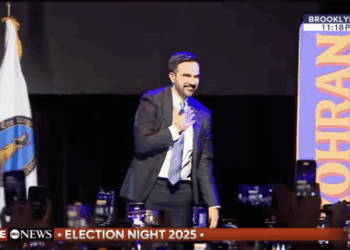Advocates of ending the seasonal clock switching between standard time and daylight saving time could find themselves a new home within the GOP’s “Make America Healthy Again” movement, as awareness grows about the negative health consequences of “falling back” and “springing forward” each year.
As people nationwide prepare to push their clocks back one hour on Sunday, Nov. 2, policymakers and health experts are ramping up the debate as to whether to “lock the clock” on either fall’s standard time or the spring and summer’s daylight saving time.
Since 2015, almost all 50 states have considered legislation to “lock the clock,” with 19 enacting permanent DST and one state, Arizona, enacting permanent standard time. But none of these state laws can take effect without the federal Congress, which has jurisdiction over time policy nationwide.
President Donald Trump this spring endorsed making DST permanent, saying on Truth Social that the biannual clock change is “a big inconvenience and, for our government, A VERY COSTLY EVENT!!!” The White House did not respond to requests for comment regarding efforts to “lock the clock” being part of the president’s MAHA goals.
But although a sizable body of scientific literature suggests that permanent standard time is the best option in terms of health, keeping the clock set to one or the other is increasingly viewed as a MAHA priority by advocates.
Jennifer Galardi, a health policy expert at the Heritage Foundation, told the Washington Examiner that she personally wants permanent standard time, but the time policy debate ought to be considered a MAHA issue regardless of time preference.
“So if we’re looking at the MAHA issue as a holistic approach to health, that everything we do, how we sleep, what we eat, how we exercise, how we engage with social media and tech, affects our overall well-being and health, then yes, I think this should be an issue,” said Galardi.
How seasonal time changes work
Jay Pea, founder of the nonprofit organization Save Standard Time, told the Washington Examiner that standard time is “an approximation of solar time,” or the natural time set by the movement of the sun. Standard time and international time zones were introduced in the 1800s as the expansion of trains and telegraphs demanded uniformity in time from place to place.
But it was not until the 1910s that commercial entities began pushing for what was then called “fast time” or what we now know as DST. Pea said that national golfing associations and department stores were the chief lobbyists for implementing DST, which artificially created longer evening hours for shopping or recreation.
Pea called DST “a trick,” “a lie,” and “weird and wrong” because it is a distortion of time as governed by the sun and the movement of the Earth, but it also has significant health implications.
Pea said that light in the morning “tells the brain to stop producing the melatonin that makes you feel drowsy and to start instead producing the cortisol, which starts to wake you up.”
“You need that morning light when you wake up, and that helps you more easily feel alert, so you don’t need to drink so much coffee in the morning, and you’re going to have a safer drive to work in the morning, and you’re going to be more productive in the workplace, and your children are going to be having an easier time learning,” Pea said.
Laura Weed, a graduate student researcher at Stanford University, told the Washington Examiner that switching times affects the body’s circadian rhythms, which she describes as the body’s “master clock” regulated by sleep patterns.
Weed said that a person’s circadian rhythm synchronizes them with the outside world, largely through responding to light exposure. The average person’s circadian rhythm is about 24.2 hours long, but it changes slightly with well-timed exposure to light.
“You need to get light exposure, particularly in the morning, to shorten the period of the circadian rhythm to 24 hours, so that you maintain synchrony with the outer world,” she said.
Health effects of time switching
Weed and her adviser, Stanford professor Jamie Zeitzer, published a groundbreaking paper in September that found implementing either permanent standard time or permanent DST would be more preferable for health than switching the clocks every season.
A good deal of scientific research has shown switching between fall’s standard time and spring’s DST increases the prevalence of a multitude of negative health outcomes, including car crashes, heart attacks, and difficulty learning in children, but little research has been conducted as to which time policy is better.
With year-round standard time, Weed and Zeitzer estimate, obesity would drop by nearly 1%, meaning about 2.6 million fewer obese people nationwide. Stroke cases would also decrease by roughly 300,0000.
Permanent DST would result in a less substantial decline in the prevalence of obesity and strokes, with 1.7 million fewer cases of obesity and 220,000 fewer cases of strokes, according to Weed and Zeitzer’s estimates.
Although she hopes her work will help inform policymakers, Weed said that economic factors and other determinants of health besides sleep-wake cycles ought to be considered as well.
“We’re really putting forward just one piece of the puzzle that should be considered in a policy decision,” said Weed. “When you’re making overarching policy decisions, there’s a lot more to consider.”
Standard Time and MAHA
Health and wellness influencers, as well as policy advocates, have shown an increasing interest in the subject of daylight saving time.
Health podcaster and Stanford neuroscience professor Andrew Huberman, highlighting Weed’s work, posted on X this week that choosing between “standard or daylight savings is perhaps a matter of personal preference but the data on mental health in adults and kids say standard is better.”
Huberman highlighted the benefits of standard time for seasonal affective disorder, but others have cited sleep cycles as essential for hormone health.
Galardi from Restoring American Wellness at the Heritage Foundation told the Washington Examiner that, aside from her personal preference for standard time, she sees the issue as part of MAHA’s overall focus on the importance of hormone regulation for metabolic health and preventing obesity, diabetes, heart disease, and other chronic diseases.
“We don’t talk about it as a really as a pillar of MAHA, but when you look at a lot of the things we’re talking about in MAHA, a lot of them have to do with hormonal balance,” said Galardi, adding, “When you kind of abruptly change the time, you are changing those sleep wake cycles and disrupting the hormonal balance in the body.”
When asked about the importance of locking the clock, Kelly McKenna, CEO of the non-partisan health group End Chronic Disease, told the Washington Examiner that “Americans are increasingly aware of the many factors that drive health outcomes, including sleep.”
McKenna highlighted the Stanford stroke and obesity prevalence study as “a reminder that something as simple as time policy has scientifically measurable effects on our long-term health.”
Pea told the Washington Examiner that his organization, Save Standard Time, sent a letter to Health and Human Services Secretary Robert F. Kennedy Jr., champion of the MAHA movement, after his confirmation, but has not received a reply.
An HHS spokesperson told the Washington Examiner that time policy is a congressional issue.
DST gets bipartisan support in Congress
Despite the mounting MAHA advocacy and most major medical organizations supporting standard time, a bipartisan group in Congress has pushed for permanent DST for several years, citing the negative health consequences of biannual shifting as a justification for it.
Over multiple sessions of Congress, Rep. Vern Buchanan (R-FL) has introduced the Sunshine Protection Act, which would establish permanent DST nationwide. Prior iterations of the bill were championed in the Senate by former Florida senator and current Secretary of State Marco Rubio.
“There are tremendous health, economic, and productivity benefits to making daylight saving time permanent. It’s clear that Americans want to do away with changing their clocks twice a year, and my bill will end this outdated practice,” Buchanan told the Washington Examiner.
Buchanan said that he has recently had “very promising conversations” with House leadership and the Energy and Commerce committee with jurisdiction over time policy about hearings to advance the Sunshine Protection Act.
Sens. Patty Murray (D-WA) and Rick Scott (R-FL) introduced a companion Senate bill to Buchanan’s in January this year, gaining 13 bipartisan co-sponsors on the legislation.
Scott and Murray’s Senate version of the Sunshine Protection Act was passed out of committee earlier this year, and Republicans attempted on Tuesday to advance the bill by unanimous consent, a Senate procedure that would expedite the legislative process.
Legislating the ‘movement of the stars’
But Sen. Tom Cotton (R-AR) thwarted this unanimous consent effort on Tuesday evening, saying during an impassioned floor speech on Tuesday that he would always vote against any measure to enact permanent daylight savings.
“By moving the clock back an hour in winter, permanent Daylight Savings Time would push winter sunrises to an absurdly late hour, depriving Americans of morning sunshine that’s essential for our safety and well-being,” said Cotton.
The Arkansas senator said that “there’s not much to be done” about the inconvenience of biannual clock switching unless we’re willing to adopt permanent Standard Time, and that “not every human problem has a legislative solution.”
“Sometimes we have to live with an uneasy compromise between competing priorities and interests. That’s doubly true when considering how the movement of the stars and the planets affects the lives of 350 million souls spread across our vast continental nation,” he said.

















